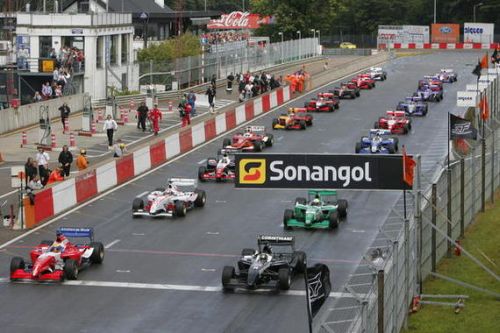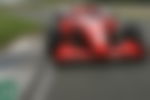

Tottenham Hotspur, Rangers, Beijing Guoan FC, this wasn’t a breakaway football tournament but a single-seater racing series: Superleague Formula. It was actually a unique way to integrate two big sports, motor racing and football.
The series’ inception was in 2008, though wasn’t the first time football teams delved into motor sport. After the series got disbanded in 2011, football’s only presence in motor racing was Sauber’s partnership with Chelsea.
Before that, Newcastle United sponsored the Lister team at the 1996 Le Mans 24 Hours. However, the idea of uniting football and motor racing stemmed from an investment company SMC Capital funding in 2001.
ADVERTISEMENT
Article continues below this ad
The Times reported in 2000 that the move would likely ‘anger’ the then F1 supremo, Bernie Ecclestone. The new series garnered attention from clubs like Manchester United, Juventus, Barcelona and Arsenal. It was also projected to bring in revenues of around £100m a year.

via Imago
Sauber with the Chelsea logo
The idea was pitched to FA chief executive Graham Kelly, who envisioned the link between the two: “Four in 10 season-ticket holders are Formula 1 fans,” he explained to The Times.
“There is going to be a lot of interest among clubs who have reached a stage where the earnings from television seem almost at saturation point.
“They are all looking for new ways of making money to cover the enormous transfer fees they are all paying and they want to spread their brands into other areas. Their names are not just football anymore.”
The cars were identical Judd V10-powered Dallaras, which tempted former F1 drivers to compete.
However, Leeds United were one of the few to get on board, despite FIA backing. The Motor Sports Association (now Motorsport UK) submitted plans for the series with British Touring Car boss Alan Gow involved. Sadly, it collapsed in ’03 due to a lack of financing.
But, Premier 1 director Robin Webb insisted on continuing the concept. “I woke up one morning and I thought ‘I’m going to make it happen, and I’m going to call it Superleague Formula’,” he recalls to Motor Sport .

via Imago
Newcastle
He had already got the green light from the heads of football clubs across Europe. This was followed up by FIA backing in 2005, with its inaugural season planned for 2008.
American sports car manufacturer, Panoz, built the cars with Menard Competition Technologies (MCT) 750hp V12 engines. However, the cars pace seemed to lack pace, as evidenced at the Nürburgring. The fastest Superleague time is 1min 41.207sec (Antônio Pizzonia, 2008). Meanwhile, Takuma Sato, in a 2004 Formula 1 car, clocked 1min 27.691sec.
When the ambitious A1GP championship crumbled, the series rose from its ashes. A1 had been tipped as the ‘World Cup of motor sport’. That series was also the brainchild of Robin Webb.
“A1 GP was actually formed out of Superleague Formula,” Webb explains. “When I was looking for funds for Superleague Formula, it went – through an intermediary – to [eventual A1 GP backer] Sheik Maktoum. He liked it and said, ‘I’m going to do this with nations’, and contacted me to set up A1 GP.”
“At the same time as A1 GP was launched, I got funding from Spain to set up Superleague Formula.”
“We didn’t like paying the football clubs for their brands, so when [A1 GP] went down I nicked its concept.”
A number of notable F1 drivers, current and former previously drove in A1GP. They were, Sebastien Buemi, Karun Chandhok, Robert Doornbos, Nico Hulkenberg, Narain Karthikeyan, Sergio Perez, Nelson Piquet Jr, Adrian Sutil, Jos Verstappen and more.

via Imago
A1 GP tried to be the World Cup of motor racing
Following A1’s disbanding, nations joined Superleague Formula’s clubs and Team China was added in 2010. That year, the champion received €1 million, with €100,000 for the winner of the Superfinal that took place at each double-header in the 11-race season.
British driver Craig Dolby, the 2010 runner-up, received €1.8m that season alone.
“The concept really felt like it’d taken off,” Dolby says. “Drivers like [Sébastien] Bourdais came back into it and as a young driver back then it was fantastic racing against these people but also being successful in the championship; week in week out the prize money kept my racing career going. At the time I was young and very grateful.”
In 2010 alone, the series boasted of six million viewers per race worldwide and even a PC game. Football teams were happy with the tie-up… even Anderlecht, which wasn’t earning a cent from Superleague.
“In my first year at Anderlecht, I was there at the ground in the box and meeting the chairman every week; taking the mechanics to the matches and they took it very seriously,” adds Dolby who drove for the team in 2008.
“They were a small club mixing with big-name clubs and it was a very big deal for it. They really enjoyed it and got behind everything, with the helmets and suits turning up in their colours. It was a pleasure to be around them and the reception was great.
“I can always remember Zolder; we opened the garage doors to a sea of Anderlecht fans for an autograph session – it was a surreal feeling. They did really work hard at making an effort to make a connection there. And I think they did.”

via Imago
2009 champions Liverpool
Webb recalls fervour in Belgium’s neighbouring Netherlands too. “They say Dutch fans are incredible anyway,” he notes. “They’d go to a flea-fighting competition. I think Assen was the best, but that was because there was an external promoter [unlike the other races].”
But then, after the highs of 2010, everything came crashing down a year later. Barely two races into the 2011 season, the series ground to a halt.
ADVERTISEMENT
Article continues below this ad
According to Webb, Superleague Formula simply ran out of money after partners, Sonangol, dropped its title sponsorship.
“We never went bankrupt – we wound up,” says Webb. “But when A1 GP went, it left a lot of very unhappy people in the marketplace; with us, everybody got paid.”
Dolby figured that the collapse was triggered when football clubs left the series in 2011. At that time, national teams such as China, England and Luxembourg took their place. Only two clubs, Sparta Prague and Atlético Madrid, remained in the sport.
ADVERTISEMENT
Article continues below this ad
“Championships come and go and that was one heck of a championship to be in; it was a shame really,” Dolby adds. “Superleague did everything right with the noise and the tyres – we could push as hard as we wanted to on the tyres and there was nothing left on the table.
“We could run a lot closer and that was one of the good sides of the championship. It was a reverse grid from race one to race two, but you could overtake and get close and run right up somebody’s rear end and have a race. It was more like Formula Ford racing with 700 horsepower.”
ADVERTISEMENT
ADVERTISEMENT
ADVERTISEMENT
ADVERTISEMENT

